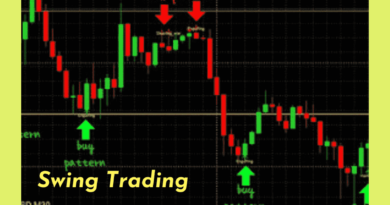Intraday Trading Strategies: Capitalizing on Quick Market Movements
What is Intraday Trading?
The art of catching price changes within a single trading day is at the heart of intraday trading, often known as day trading. It’s a technique that needs careful consideration, prompt decision-making, and the capacity to handle fluctuations in market volatility.
Unlike longer-term investment approaches, where positions are held for weeks, months, or even years, intraday traders seek to capitalize on short-lived opportunities that arise within the span of a single market session.
This intense focus on the microcosm of a trading day demands a unique set of skills, strategies, and insights.
Key Characteristics of Intraday Trading
- Intraday traders seek to profit from quick price movements that transpire within minutes or hours. The positions are closed before the trading day concludes.
- Unlike other trading styles, intraday traders do not hold positions overnight, minimizing exposure to overnight news events that can lead to price gaps.
- Intraday traders execute multiple trades within a single trading day, leveraging a high trading volume to capture small gains from each trade.
- Intraday trading thrives in volatile markets, as increased price fluctuations create opportunities for swift gains.
- Liquid markets with ample trading volume allow intraday traders to enter and exit positions with ease, reducing the impact of slippage.
- Due to the rapid pace of trading, effective risk management is paramount to safeguarding capital from large losses.
Intraday Trading Strategies
Some of the prominent intraday trading strategies that traders employ to capture short-term gains are:
Scalping Strategy:
Scalping stands as one of the most rapid-fire intraday strategies, focused on capitalizing on the smallest price movements. Scalpers execute numerous trades throughout the day, aiming to accumulate profits from each small price fluctuation. This strategy demands keen observation, quick decision-making, and the ability to enter and exit positions swiftly. Scalpers often leverage technical indicators, such as moving averages or stochastics, to identify entry and exit points.
Breakout Strategy:
The breakout strategy hinges on identifying price levels where assets break through established support or resistance levels. Traders await a breakout with high trading volume, indicative of a potential trend reversal or continuation. This strategy requires patience, as traders wait for confirmation of the breakout before entering positions.
Reversal Strategy:
Reversal strategies involve anticipating trend reversals based on technical indicators or patterns that suggest an imminent shift in direction. Traders seek out overbought or oversold conditions to predict price reversals and enter positions against the prevailing trend.
Momentum Strategy:
Momentum traders ride the wave of strong price movements, aiming to capitalize on the continuation of existing trends. This strategy involves entering positions when an asset’s price demonstrates significant momentum, as indicated by high trading volume and substantial price changes.
Gap Trading Strategy:
Gap trading focuses on capitalizing on price gaps that occur between the closing and opening prices of consecutive trading sessions. Traders analyze the reason behind the gap, whether due to news events or market sentiment, to predict price movements and execute trades accordingly.

Support and Resistance Strategy:
This strategy centers on identifying key support and resistance levels and using them to make trading decisions. Traders enter long positions near support levels and short positions near resistance levels, expecting price reversals.
Moving Average Crossover Strategy:
Traders using moving averages look for crossovers between short-term and long-term moving averages to identify potential buy or sell signals. A bullish crossover occurs when the short-term moving average crosses above the long-term moving average, signaling a potential uptrend, and vice versa for a bearish crossover.
Pivot Point Strategy:
Pivot points are levels calculated based on the previous day’s high, low, and closing prices. Traders use pivot points as potential support and resistance levels. They may enter positions based on price behavior around these levels.
Pattern-Based Strategies:
Pattern-based strategies involve recognizing chart patterns such as triangles, flags, and head and shoulders. Traders use these patterns to predict potential price movements and enter positions accordingly.
Arbitrage Strategy:
Arbitrageurs seek to profit from price discrepancies between different markets or assets. In intraday trading, this might involve buying an asset on one exchange and selling it at a higher price on another, aiming to capture risk-free gains.
Note: The choice of strategy is influenced by a number of variables, including market conditions, asset liquidity, the trader’s risk appetite, and expertise with particular strategies.
Successful intraday traders often combine their approaches and modify them in response to shifting market dynamics.
Tools and Indicators of Intraday Trading
Equipping oneself with the appropriate tools and indicators is crucial for success in the world of intraday trading, where decisions made in a split second can be the difference between success and failure.
Let’s look at some of the essential resources and tools used by intraday traders:
Candlestick Charts:
Candlestick charts provide a visual representation of price movements within a specific time frame. Each candlestick displays the opening, closing, high, and low prices, forming patterns that help traders identify trends, reversals, and potential entry points.
Technical Indicators:
A. Moving Averages: Moving averages smooth out price data to reveal underlying trends. Traders often use crossovers between short-term (faster) and long-term (slower) moving averages to identify potential trend changes.
B. Relative Strength Index (RSI): The RSI measures the speed and change of price movements, indicating whether an asset is overbought or oversold. Traders use RSI levels to assess potential reversals or continuation of trends.
C. Moving Average Convergence Divergence (MACD): The MACD is a trend-following momentum indicator that helps traders identify trend changes, momentum shifts, and potential buy or sell signals.
D. Stochastic Oscillator: This oscillator compares an asset’s closing price to its price range over a specified period. It helps traders determine overbought and oversold conditions, indicating potential reversals.
Volume Analysis:
Understanding the strength of price swings can be gained by analyzing trading volume. Increased volume during price changes suggests strong market participation, confirming potential trends or reversals.
Support and Resistance Levels:
Identifying support (price level where an asset tends to stop falling) and resistance (price level where an asset tends to stop rising) levels helps traders make informed decisions about entry and exit points.
Trendlines and Channels:
Drawing trendlines and channels on charts helps visualize the overall trend direction. Breakouts from these lines can signal potential entry points.
Fibonacci Retracement:
A price trend’s possible support and resistance levels can be found by using Fibonacci retracement levels, which are based on mathematical ratios. Traders employ these levels to anticipate potential price reversals.
Real-Time News and Economic Calendars:
Staying updated with real-time news releases and economic events is crucial, as they can lead to sudden price movements and impact intraday trading decisions.
Level II Data:
Level II data provides information about buy and sell orders in the market, allowing traders to gauge supply and demand at different price levels.
Trading Platforms and Software:
Intraday traders rely on advanced trading platforms that offer real-time data, customizable charts, technical indicators, and order execution capabilities.
Mobile Apps:
Mobile trading apps allow traders to monitor and execute trades on the go, providing flexibility and the ability to react to market movements quickly.
Preparing for Intraday Trading
Your ability to compile information, plan your trades, and execute your ideas precisely will determine your success in this dynamic trading method. Here is a detailed preparation manual to assist you in getting ready for intraday trading:
1. Pre-Market Research:
- Before the trading day begins, engage in thorough pre-market research to gather essential information that will inform your trading decisions:
- Review relevant news: Stay updated on overnight developments, economic data releases, and market-moving news that can impact your chosen assets.
- Analyze the global market: Observe international markets that can influence your trading instruments.
- Check earnings reports and economic calendars: Note any scheduled corporate earnings releases or economic data announcements that might lead to heightened volatility.
2. Create a Watch list:
Based on your pre-market research, create a watch list of assets you’re interested in trading. Narrow down the list to those with potential for intraday price movements and that align with your chosen strategies.
3. Set Trading Goals:
Establish clear trading goals for the day. Define how much profit you aim to achieve, the number of trades you intend to make, and the maximum loss you’re willing to tolerate. Having well-defined goals keeps you focused and helps prevent emotional decision-making.
4. Develop a Trading Plan:
Craft a detailed trading plan that outlines your strategy, entry and exit criteria, risk management rules, and contingency plans. Your plan should also include guidelines for adapting to changing market conditions.
5. Technical Analysis:
Perform a technical analysis to locate possible entry and exit points. Use tools like candlestick patterns, technical indicators, and chart patterns to anticipate price movements.
6. Choose Your Trading Strategies:
Based on the market conditions and your analysis, decide which intraday trading strategies you’ll employ for the day. Different strategies might work better in varying market conditions, so adapt your approach accordingly.
7. Risk Management:
- Adopt sensible risk-management techniques to safeguard your money.
- Based on your risk tolerance and account size, choose the right position size.
- Put stop-loss orders in place to reduce possible losses on each trade.
- Follow a risk-reward ratio that ensures potential gains outweigh potential losses.
8. Stay Disciplined:
Maintain emotional discipline throughout the trading day. Adhere to your trading strategy, refrain from acting on impulse, and control your emotions.
9. Utilize Technology:
Ensure your trading platform is up and running, with access to real-time data, charts, and order execution capabilities.
10. Maintain a Trading Journal:
Keep a detailed trading journal to record each trade you make. Note the rationale behind each trade, your emotions, outcomes, and lessons learned. Regularly reviewing your journal can help you refine your strategies over time.
11. Test Your Strategies:
If you’re new to intraday trading or trying a new strategy, consider testing it in a demo account before trading with real money. This allows you to practice without risking capital.
12. Time Management:
Allocate specific time blocks for trading, research, and breaks. Staying focused during your trading hours is essential to making informed decisions.
Advantages of Intraday Trading
- Intraday trading offers the opportunity to capitalize on short-term price movements, potentially leading to quick profits within a single trading day.
- Since intraday traders close all positions by the end of the trading day, they are not exposed to the risk of overnight news events or price gaps.
- Intraday trading can be started with smaller capital compared to long-term investing or trading approaches that require holding positions for extended periods.
- Intraday traders do not need to pay overnight holding costs or carry charges, which are common in positions held for longer durations.
- Intraday trading allows traders to take advantage of market volatility without tying up their capital for extended periods.
- Traders can practice strategies in real-time conditions without waiting for days or weeks to see the results.
Disadvantages of Intraday Trading
- Intraday trading can be subject to high levels of market volatility, which can lead to rapid price fluctuations and unexpected losses.
- The need to make quick decisions and manage multiple trades can lead to emotional stress, causing traders to make impulsive decisions.
- Frequent trading leads to higher transaction costs due to commissions, spreads, and fees, which can eat into potential profits.
- Intraday traders often focus on a few assets, limiting diversification compared to longer-term investment approaches.
- Intraday trading requires constant monitoring of the markets during trading hours, which can be demanding and might not suit everyone’s lifestyle.
- Traders need to process a significant amount of information quickly to make informed decisions, which can lead to information overload.
- While the potential for quick profits exists, the gains from individual trades might be smaller compared to longer-term investment strategies.
- Successful intraday trading requires a deep understanding of technical analysis, chart patterns, indicators, and quick decision-making skills.



